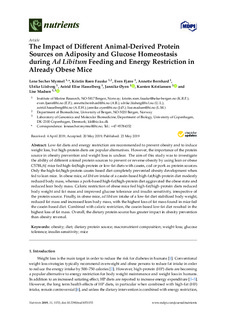The impact of different animal-derived protein sources on adiposity and glucose homeostasis during ad libitum feeding and energy restriction in already obese mice
| dc.contributor.author | Myrmel, Lene Secher | |
| dc.contributor.author | Fauske, Kristin Røen | |
| dc.contributor.author | Fjære, Even | |
| dc.contributor.author | Bernhard, Annette | |
| dc.contributor.author | Liisberg, Ulrike | |
| dc.contributor.author | Hasselberg, Astrid Elise | |
| dc.contributor.author | Øyen, Jannike | |
| dc.contributor.author | Kristiansen, Karsten | |
| dc.contributor.author | Madsen, Lise | |
| dc.date.accessioned | 2019-08-22T11:52:12Z | |
| dc.date.available | 2019-08-22T11:52:12Z | |
| dc.date.created | 2019-07-30T12:05:07Z | |
| dc.date.issued | 2019 | |
| dc.identifier.citation | Nutrients. 2019, 11:1153 (5), 1-19. | nb_NO |
| dc.identifier.issn | 2072-6643 | |
| dc.identifier.uri | http://hdl.handle.net/11250/2609838 | |
| dc.description.abstract | Low-fat diets and energy restriction are recommended to prevent obesity and to induce weight loss, but high-protein diets are popular alternatives. However, the importance of the protein source in obesity prevention and weight loss is unclear. The aim of this study was to investigate the ability of different animal protein sources to prevent or reverse obesity by using lean or obese C57BL/6J mice fed high-fat/high-protein or low-fat diets with casein, cod or pork as protein sources. Only the high-fat/high-protein casein-based diet completely prevented obesity development when fed to lean mice. In obese mice, ad libitum intake of a casein-based high-fat/high-protein diet modestly reduced body mass, whereas a pork-based high-fat/high-protein diet aggravated the obese state and reduced lean body mass. Caloric restriction of obese mice fed high-fat/high-protein diets reduced body weight and fat mass and improved glucose tolerance and insulin sensitivity, irrespective of the protein source. Finally, in obese mice, ad libitum intake of a low-fat diet stabilized body weight, reduced fat mass and increased lean body mass, with the highest loss of fat mass found in mice fed the casein-based diet. Combined with caloric restriction, the casein-based low-fat diet resulted in the highest loss of fat mass. Overall, the dietary protein source has greater impact in obesity prevention than obesity reversal. | nb_NO |
| dc.language.iso | eng | nb_NO |
| dc.title | The impact of different animal-derived protein sources on adiposity and glucose homeostasis during ad libitum feeding and energy restriction in already obese mice | nb_NO |
| dc.type | Journal article | nb_NO |
| dc.type | Peer reviewed | nb_NO |
| dc.description.version | publishedVersion | nb_NO |
| dc.source.pagenumber | 1-19 | nb_NO |
| dc.source.volume | 11:1153 | nb_NO |
| dc.source.journal | Nutrients | nb_NO |
| dc.source.issue | 5 | nb_NO |
| dc.identifier.doi | 10.3390/nu11051153 | |
| dc.identifier.cristin | 1713175 | |
| dc.relation.project | Fiskeri- og havbruksnæringens forskningsfond: 900842 | nb_NO |
| dc.relation.project | EC/FP7/278373 | nb_NO |
| cristin.unitcode | 7431,35,0,0 | |
| cristin.unitcode | 7431,0,0,0 | |
| cristin.unitcode | 7431,34,0,0 | |
| cristin.unitname | Sjømat i modellsystem | |
| cristin.unitname | Havforskningsinstituttet | |
| cristin.unitname | Matsikkerhet og ernæring | |
| cristin.ispublished | true | |
| cristin.fulltext | original | |
| cristin.qualitycode | 1 |
Tilhørende fil(er)
Denne innførselen finnes i følgende samling(er)
-
Articles [3012]
-
Publikasjoner fra CRIStin [3070]
